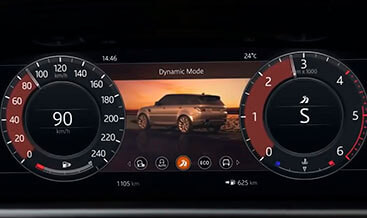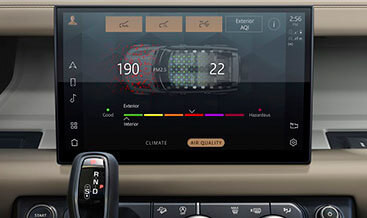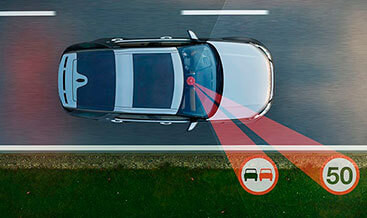Velar All Terrain Progress Control (ATPC) Explained
Velar All Terrain Progress Control (ATPC) is an advanced driver assistance system, offering unparalleled control and stability across various terrains. At CARDIAGTECH.NET, we understand the importance of keeping your Velar performing at its peak. This comprehensive guide explores ATPC, its benefits, and how to maintain it. Proper maintenance ensures your Velar’s off-road capabilities remain top-notch, boosting vehicle reliability and safety performance.
1. Understanding Velar All Terrain Progress Control (ATPC)
Velar All Terrain Progress Control (ATPC) is a sophisticated system designed to enhance off-road driving capabilities. It acts like a low-speed cruise control, allowing the driver to focus on steering while the vehicle manages throttle and braking.
1.1. Definition of ATPC
ATPC is an advanced system that automatically manages engine output and braking to maintain a steady speed in challenging driving conditions. The system operates at very low speeds, typically between 1 mph and 18 mph (1.6 km/h and 30 km/h), making it ideal for navigating difficult terrains like mud, sand, gravel, and snow. According to Land Rover, ATPC is designed to “enable drivers to concentrate on steering and negotiating difficult obstacles.”
1.2. How ATPC Works
ATPC integrates several vehicle systems to function effectively:
- Engine Management: The system controls the engine’s throttle to provide the necessary torque for traction.
- Braking System: ATPC uses the anti-lock braking system (ABS) to apply precise braking force to individual wheels, preventing wheel spin and maintaining stability.
- Terrain Response: ATPC often works in conjunction with Land Rover’s Terrain Response system, which optimizes the vehicle’s settings for different types of surfaces.
- Sensors: Wheel speed sensors and other data inputs provide real-time information to the system, allowing it to adjust as needed.
1.3. Benefits of Using ATPC
- Enhanced Control: ATPC allows drivers to maintain steady progress in challenging conditions, reducing the risk of getting stuck.
- Reduced Driver Fatigue: By managing throttle and braking, ATPC minimizes the physical and mental strain on the driver, especially during long off-road excursions.
- Improved Safety: The system helps maintain stability and control, reducing the likelihood of accidents in slippery or uneven terrain.
- Optimized Performance: ATPC ensures the vehicle operates at its most efficient settings for the given terrain, maximizing traction and minimizing wear and tear.
2. Key Components of the Velar ATPC System
The Velar ATPC system consists of several interconnected components, each playing a crucial role in its overall functionality. Understanding these components can help in diagnosing and maintaining the system effectively.
2.1. Electronic Control Unit (ECU)
The ECU is the brain of the ATPC system, processing data from various sensors and controlling the engine and braking systems.
- Function: The ECU receives inputs from wheel speed sensors, throttle position sensors, and the Terrain Response system. It then calculates the appropriate engine output and braking force needed to maintain the desired speed.
- Maintenance Tips: Regularly check for software updates to ensure the ECU is running the latest version. Keep the ECU dry and free from corrosion.
2.2. Wheel Speed Sensors
These sensors monitor the speed of each wheel, providing critical data for the ATPC system to prevent wheel spin.
- Function: Wheel speed sensors detect if a wheel is losing traction and send this information to the ECU, which then adjusts the braking force to that wheel.
- Maintenance Tips: Clean the sensors regularly to remove dirt and debris. Inspect the sensor wires for damage. Replace faulty sensors promptly.
2.3. Brake Actuators
Brake actuators apply the necessary braking force to individual wheels as directed by the ECU.
- Function: These actuators use hydraulic pressure to control the brakes, allowing the ATPC system to precisely manage wheel speed and prevent slippage.
- Maintenance Tips: Ensure the brake fluid is at the correct level and is free from contaminants. Check for leaks in the brake lines and actuators.
2.4. Throttle Control System
The throttle control system manages the engine’s output to provide the necessary torque for maintaining speed.
- Function: This system adjusts the throttle position based on the ECU’s commands, ensuring the engine delivers the right amount of power for the terrain.
- Maintenance Tips: Check the throttle linkage for smooth operation. Ensure the throttle position sensor is functioning correctly.
2.5. Terrain Response System Integration
The Terrain Response system works in conjunction with ATPC to optimize vehicle settings for different surfaces.
- Function: Terrain Response allows the driver to select a specific terrain mode (e.g., mud, sand, snow), which adjusts the vehicle’s parameters, including throttle response, traction control, and suspension settings. ATPC then works within these parameters to maintain steady progress.
- Maintenance Tips: Regularly calibrate the Terrain Response system. Ensure all terrain modes are functioning correctly.
3. Diagnosing Common Issues with Velar ATPC
Identifying and addressing common issues in the Velar ATPC system can prevent minor problems from escalating into major repairs. At CARDIAGTECH.NET, we provide the tools and knowledge to help you keep your Velar in top condition.
3.1. Warning Lights and Error Messages
Warning lights on the dashboard can indicate problems with the ATPC system. Common error messages may include “ATPC Fault” or “Terrain Response Not Available.”
- Troubleshooting: Use a diagnostic scanner to read the error codes and identify the specific issue. Consult the vehicle’s service manual for guidance on interpreting the codes.
3.2. System Not Engaging
If the ATPC system fails to engage when activated, several factors could be responsible.
- Possible Causes:
- Faulty wheel speed sensor
- Problem with the ECU
- Issue with the brake actuators
- Incorrect Terrain Response settings
- Troubleshooting:
- Check the wheel speed sensors for damage or contamination.
- Use a diagnostic scanner to check for ECU error codes.
- Inspect the brake actuators for proper function.
- Ensure the Terrain Response system is set to an appropriate mode.
3.3. Erratic Speed Control
Inconsistent speed control can be a sign of issues with the throttle control system or wheel speed sensors.
- Possible Causes:
- Dirty or faulty throttle position sensor
- Inaccurate wheel speed sensor readings
- Vacuum leaks in the throttle system
- Troubleshooting:
- Clean the throttle position sensor and check its connections.
- Inspect the wheel speed sensors for damage or contamination.
- Check for vacuum leaks in the throttle system.
3.4. System Disengaging Unexpectedly
The ATPC system may disengage unexpectedly due to various reasons, including sensor failures or system errors.
- Possible Causes:
- Intermittent sensor failures
- Software glitches in the ECU
- Overheating of system components
- Troubleshooting:
- Use a diagnostic scanner to identify any stored error codes.
- Check the system components for overheating.
- Ensure the ECU has the latest software updates.
4. Step-by-Step Guide to Maintaining Velar ATPC
Regular maintenance is crucial for ensuring the Velar ATPC system operates reliably. Follow these steps to keep your system in optimal condition.
4.1. Regular Inspections
Conduct routine inspections of the ATPC system components to identify potential issues early.
- Checklist:
- Inspect wheel speed sensors for damage and contamination.
- Examine brake lines and actuators for leaks.
- Check the throttle linkage for smooth operation.
- Verify the Terrain Response system is functioning correctly.
4.2. Cleaning and Protecting Sensors
Keeping the sensors clean and protected from the elements is essential for accurate readings.
- Steps:
- Disconnect the sensor.
- Use a soft brush to remove dirt and debris.
- Apply a sensor-safe cleaner to remove stubborn contaminants.
- Allow the sensor to dry completely before reconnecting.
4.3. Brake System Maintenance
Proper brake system maintenance is vital for the ATPC system to function correctly.
- Steps:
- Check the brake fluid level and condition.
- Inspect brake pads and rotors for wear.
- Bleed the brake lines to remove air bubbles.
- Ensure the brake calipers are functioning correctly.
4.4. Software Updates
Keep the ECU software up to date to ensure optimal performance and compatibility.
- Process:
- Connect a diagnostic scanner to the vehicle.
- Check for available software updates for the ECU.
- Follow the scanner’s prompts to install the updates.
- Verify the updates were installed correctly.
4.5. Professional Servicing
Schedule regular professional servicing to address issues beyond routine maintenance.
- Benefits:
- Expert diagnosis of complex problems
- Access to specialized tools and equipment
- Warranty coverage for repairs
5. Tools and Equipment for ATPC Maintenance
Having the right tools and equipment is essential for effective ATPC maintenance. CARDIAGTECH.NET offers a wide range of high-quality tools to meet your needs.
5.1. Diagnostic Scanners
Diagnostic scanners are crucial for reading error codes and diagnosing issues with the ATPC system.
- Features to Look For:
- Compatibility with Land Rover vehicles
- Ability to read and clear error codes
- Real-time data monitoring
- Software update capabilities
5.2. Multimeters
Multimeters are used to measure voltage, current, and resistance in electrical circuits, helping to diagnose sensor and wiring issues.
- Key Features:
- Digital display for accurate readings
- Automatic ranging
- Continuity testing
- Ability to measure AC and DC voltage
5.3. Brake Bleeding Kits
Brake bleeding kits facilitate the removal of air bubbles from the brake lines, ensuring optimal braking performance.
- Types of Kits:
- Manual brake bleeders
- Pressure brake bleeders
- Vacuum brake bleeders
5.4. Sensor Cleaning Supplies
Specialized cleaning supplies are needed to safely clean and protect the ATPC system sensors.
- Recommended Products:
- Sensor-safe cleaners
- Soft brushes
- Microfiber cloths
5.5. Torque Wrenches
Torque wrenches ensure bolts and fasteners are tightened to the correct specifications, preventing damage to components.
- Types of Torque Wrenches:
- Click-type torque wrenches
- Digital torque wrenches
- Beam-type torque wrenches
6. Common Problems and Solutions
Addressing common issues promptly can prevent them from causing further damage to the ATPC system.
6.1. Wheel Speed Sensor Failure
Wheel speed sensor failures can disrupt the ATPC system’s ability to control wheel spin.
- Symptoms:
- ATPC system not engaging
- Error messages on the dashboard
- Erratic speed control
- Solutions:
- Diagnose the faulty sensor using a diagnostic scanner.
- Replace the sensor with a new one.
- Clear the error codes and test the system.
6.2. Brake Actuator Issues
Problems with the brake actuators can affect the system’s ability to apply precise braking force.
- Symptoms:
- Uneven braking
- ATPC system not functioning correctly
- Brake fluid leaks
- Solutions:
- Inspect the brake actuators for leaks and damage.
- Replace faulty actuators.
- Bleed the brake lines to remove air bubbles.
6.3. Throttle Position Sensor Malfunction
A malfunctioning throttle position sensor can lead to erratic engine behavior and affect the ATPC system’s performance.
- Symptoms:
- Rough idling
- Poor acceleration
- ATPC system not engaging
- Solutions:
- Test the throttle position sensor with a multimeter.
- Replace the sensor if it is faulty.
- Calibrate the new sensor.
6.4. ECU Software Glitches
Software glitches in the ECU can cause various issues with the ATPC system.
- Symptoms:
- Intermittent system failures
- Error messages on the dashboard
- Unpredictable system behavior
- Solutions:
- Check for software updates using a diagnostic scanner.
- Install the latest updates.
- Reset the ECU if necessary.
7. Upgrading Your Velar ATPC System
Enhancing your Velar ATPC system can provide even greater off-road capabilities and performance.
7.1. Aftermarket Components
Consider installing aftermarket components to improve the ATPC system’s performance.
- Options:
- Upgraded wheel speed sensors for more accurate readings
- High-performance brake actuators for better control
- ECU tuning for optimized performance
7.2. Software Enhancements
Software enhancements can unlock additional features and improve the system’s responsiveness.
- Options:
- Custom tuning for specific terrains
- Enhanced traction control algorithms
- Improved integration with the Terrain Response system
7.3. Suspension Upgrades
Upgrading the suspension system can complement the ATPC system, providing better stability and control in challenging conditions.
- Options:
- Lift kits for increased ground clearance
- Heavy-duty shock absorbers for improved damping
- Air suspension upgrades for adjustable ride height
8. Safety Tips When Using ATPC
While ATPC enhances control and safety, it’s important to follow safety guidelines to prevent accidents.
8.1. Understanding System Limitations
Be aware of the ATPC system’s limitations. It is not a substitute for careful driving and may not be effective in all conditions.
- Factors to Consider:
- Extreme weather conditions
- Very steep inclines or declines
- Unfamiliar terrain
8.2. Maintaining Awareness
Always remain alert and maintain awareness of your surroundings, even when using ATPC.
- Tips:
- Keep your hands on the steering wheel.
- Monitor the vehicle’s progress and be prepared to take control if necessary.
- Adjust the system speed to match the terrain.
8.3. Proper Training
Consider taking a professional off-road driving course to learn how to use ATPC effectively and safely.
- Benefits:
- Learn advanced driving techniques.
- Gain experience in challenging conditions.
- Understand the vehicle’s capabilities and limitations.
8.4. Regular System Checks
Perform regular system checks to ensure the ATPC is functioning correctly.
- Checklist:
- Verify the system engages and disengages smoothly.
- Monitor for any warning lights or error messages.
- Test the system in a controlled environment before tackling challenging terrain.
9. Real-World Applications of Velar ATPC
The Velar ATPC system is designed to handle a variety of real-world driving scenarios, providing enhanced control and stability.
9.1. Off-Roading Adventures
ATPC is particularly useful for off-road adventures, allowing drivers to navigate challenging terrains with confidence.
- Examples:
- Crawling over rocks and boulders
- Traversing muddy trails
- Climbing steep inclines
- Descending slippery slopes
9.2. Navigating Inclement Weather
ATPC can help maintain control in inclement weather conditions, such as snow, ice, and rain.
- Examples:
- Driving on snow-covered roads
- Navigating icy patches
- Maintaining traction in heavy rain
9.3. Towing and Hauling
ATPC can assist with towing and hauling, providing enhanced stability and control when carrying heavy loads.
- Examples:
- Towing a trailer on uneven terrain
- Hauling equipment up steep hills
- Maintaining control on slippery surfaces
9.4. Everyday Driving Scenarios
Even in everyday driving scenarios, ATPC can provide added safety and convenience.
- Examples:
- Driving on gravel roads
- Navigating construction zones
- Maintaining control in unexpected situations
10. Why Choose CARDIAGTECH.NET for Your Velar ATPC Needs
CARDIAGTECH.NET is your trusted partner for all your Velar ATPC maintenance and repair needs.
10.1. High-Quality Products
We offer a wide range of high-quality tools and equipment specifically designed for maintaining the Velar ATPC system.
- Product Categories:
- Diagnostic scanners
- Wheel speed sensors
- Brake actuators
- Throttle position sensors
- Sensor cleaning supplies
10.2. Expert Advice
Our team of experienced technicians can provide expert advice and guidance on diagnosing and resolving ATPC system issues.
- Services:
- Technical support
- Troubleshooting assistance
- Maintenance tips
10.3. Competitive Pricing
We offer competitive pricing on all our products and services, ensuring you get the best value for your money.
- Benefits:
- Affordable tools and equipment
- Cost-effective maintenance solutions
- Budget-friendly repair options
10.4. Exceptional Customer Service
We are committed to providing exceptional customer service and support, ensuring your satisfaction with every purchase.
- Features:
- Fast and reliable shipping
- Easy returns
- Dedicated customer support team
Maintaining your Velar All Terrain Progress Control (ATPC) system is essential for ensuring optimal performance and safety. At CARDIAGTECH.NET, we understand the challenges you face as automotive technicians and garage owners. The physical demands of the job, exposure to harsh chemicals, and the constant need to update your skills can be overwhelming. That’s why we offer a comprehensive range of high-quality tools and equipment to help you work more efficiently, accurately, and safely.
Don’t let the complexities of ATPC maintenance slow you down. Contact us today via Whatsapp at +1 (641) 206-8880 or visit our website CARDIAGTECH.NET at 276 Reock St, City of Orange, NJ 07050, United States, and let our expert team assist you in finding the perfect solutions for your needs. Invest in the right tools, enhance your skills, and elevate your service quality with CARDIAGTECH.NET.
FAQ: Velar All Terrain Progress Control (ATPC)
1. What exactly is Velar All Terrain Progress Control (ATPC)?
ATPC is a driver assistance system that functions like a low-speed cruise control, helping drivers maintain a steady speed on challenging terrains by automatically managing engine output and braking.
2. How does ATPC improve off-road driving?
ATPC enhances control, reduces driver fatigue, improves safety, and optimizes vehicle performance by managing throttle and braking, allowing the driver to focus on steering.
3. What are the key components of the Velar ATPC system?
The main components include the Electronic Control Unit (ECU), wheel speed sensors, brake actuators, throttle control system, and integration with the Terrain Response system.
4. How often should I inspect the ATPC system?
Regular inspections should be conducted routinely, checking wheel speed sensors, brake lines, throttle linkage, and the Terrain Response system for any potential issues.
5. What tools are essential for ATPC maintenance?
Essential tools include diagnostic scanners, multimeters, brake bleeding kits, sensor cleaning supplies, and torque wrenches.
6. What are common warning signs of ATPC system issues?
Common signs include warning lights, error messages, system not engaging, erratic speed control, and the system disengaging unexpectedly.
7. How can I update the software for my Velar’s ECU?
Software updates can be performed using a diagnostic scanner connected to the vehicle, following the scanner’s prompts to install the latest updates.
8. Is it safe to use ATPC in all driving conditions?
While ATPC enhances control, it’s crucial to understand its limitations and maintain awareness of your surroundings, especially in extreme weather or unfamiliar terrain.
9. Can aftermarket components improve ATPC performance?
Yes, aftermarket components like upgraded wheel speed sensors, high-performance brake actuators, and ECU tuning can enhance the ATPC system’s performance.
10. Where can I find high-quality tools and expert advice for ATPC maintenance?
CARDIAGTECH.NET offers a wide range of high-quality tools and expert advice to help you maintain your Velar ATPC system effectively.








